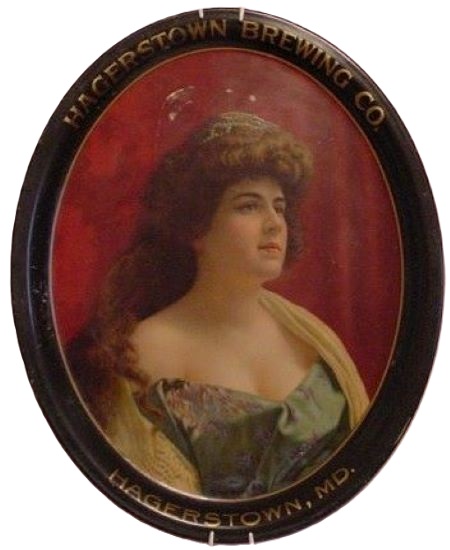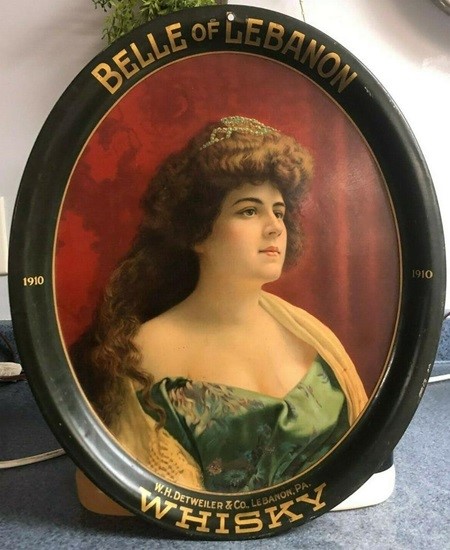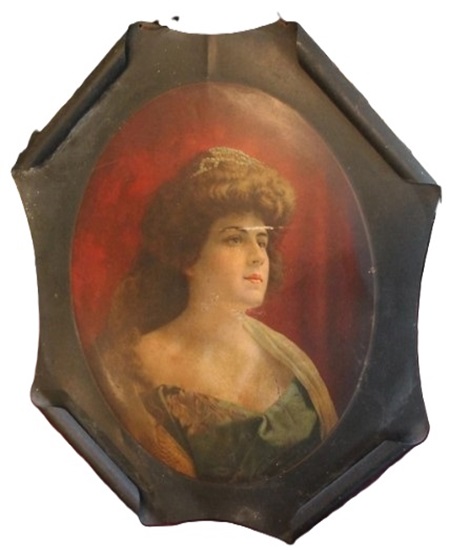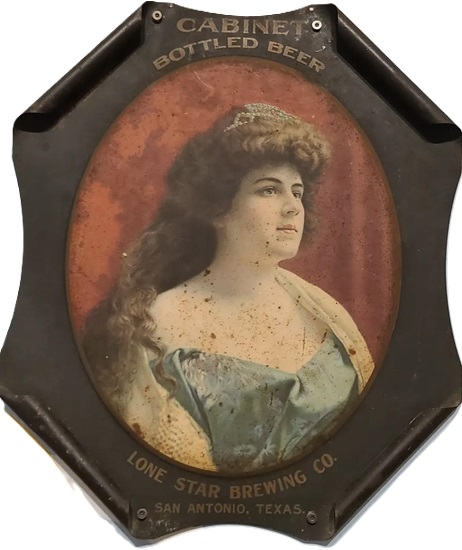The 'Stock' Exchange
The Meek Co.: No. 95 "Carmen"
The Meek Co.: No. 95 "Carmen"
Date: 1908 - 1910
Size: 13.5" x 16.5"
Type: Inverted Pie
Scarcity: Rare
Value: $$$ to $$$$
Condition & Brewer Dependent
Size: 13.5" x 16.5"
Type: Inverted Pie
Scarcity: Rare
Value: $$$ to $$$$
Condition & Brewer Dependent
General
No. 95 seems like the last of a spurt of the “Victorian Lady” designs, although a few crop up somewhat randomly later in the catalog. The odd thing about this design is that it is the only oval in the midst of a string of square, small oblong and convex pie shaped trays during this timeframe. In fact, it may be the last (with unaccounted for stock numbers being a possible exception) of the larger, pie-shaped oval designs. These were characterized by a low, flat convex rim; later ovals were narrower with a steeper concave rim.
Although used as male name in Hispanic cultures, as a female name Carmen’s origins also appear to be Latin, meaning ode or poem and is the root of the English word “charm.” It was rising in popularity in the early 20th century before plateauing in the mid-1920s through the mid-1980s. It remains popular in Spain and is frequently associated with titles related to the Virgin Mary (e.g., “Virgen del Carmen” or “Nuestra Señora del Carmen” (virgin of the mountain Carmel).
No. 95 seems like the last of a spurt of the “Victorian Lady” designs, although a few crop up somewhat randomly later in the catalog. The odd thing about this design is that it is the only oval in the midst of a string of square, small oblong and convex pie shaped trays during this timeframe. In fact, it may be the last (with unaccounted for stock numbers being a possible exception) of the larger, pie-shaped oval designs. These were characterized by a low, flat convex rim; later ovals were narrower with a steeper concave rim.
Although used as male name in Hispanic cultures, as a female name Carmen’s origins also appear to be Latin, meaning ode or poem and is the root of the English word “charm.” It was rising in popularity in the early 20th century before plateauing in the mid-1920s through the mid-1980s. It remains popular in Spain and is frequently associated with titles related to the Virgin Mary (e.g., “Virgen del Carmen” or “Nuestra Señora del Carmen” (virgin of the mountain Carmel).
Confirmed Brewer used Stock Trays

Non-Beer Related & Non-Tray Uses

The seemingly obvious inspiration for this design is Georges Bizet’s 1875 opera by the same name (and in this design the lady depicted does have an operatic look to her). By 1885 it had become incredibly popular and remains among the most frequently performed classical operas of all time. It was a bit of a surprise to learn that Bizet’s work was based on an earlier novella of the same title by Prosper Mérimée.
It is set in southern Spain and tells the story of the downfall of Don José, a naïve soldier who is seduced by the wiles of the fiery gypsy Carmen. José abandons his childhood sweetheart and deserts from his military duties, yet loses Carmen's love to the glamorous torero Escamillo, after which José kills her in a jealous rage. The depictions of proletarian life, immorality, and lawlessness, and the tragic death of the main character on stage, broke new ground in French opera and were highly controversial.
The woman depicted in this design bears some resemblance to Andreina Beinat (Mezzo-Soprano) a now forgotten Spanish performer who played the role of Carmen in a 1905 production in Italy and then again 1915 (possibly in Argentina). Although it’s dubious that she was the actual “model” for this design, she does conform with the stereotype of female opera singers invoked by the well known expression “It ain’t over till the fat lady sings.”
Sahling has a September 1908 entry in his workbook for “Carmen” listed as “stock oval tray No. 95.” Oddly there is also an April 1909 entry for “Stock medallion Carmen.” We don’t find any other entries for “medallion” in his workbook, so we are not entirely sure what this means.
It is set in southern Spain and tells the story of the downfall of Don José, a naïve soldier who is seduced by the wiles of the fiery gypsy Carmen. José abandons his childhood sweetheart and deserts from his military duties, yet loses Carmen's love to the glamorous torero Escamillo, after which José kills her in a jealous rage. The depictions of proletarian life, immorality, and lawlessness, and the tragic death of the main character on stage, broke new ground in French opera and were highly controversial.
The woman depicted in this design bears some resemblance to Andreina Beinat (Mezzo-Soprano) a now forgotten Spanish performer who played the role of Carmen in a 1905 production in Italy and then again 1915 (possibly in Argentina). Although it’s dubious that she was the actual “model” for this design, she does conform with the stereotype of female opera singers invoked by the well known expression “It ain’t over till the fat lady sings.”
Sahling has a September 1908 entry in his workbook for “Carmen” listed as “stock oval tray No. 95.” Oddly there is also an April 1909 entry for “Stock medallion Carmen.” We don’t find any other entries for “medallion” in his workbook, so we are not entirely sure what this means.
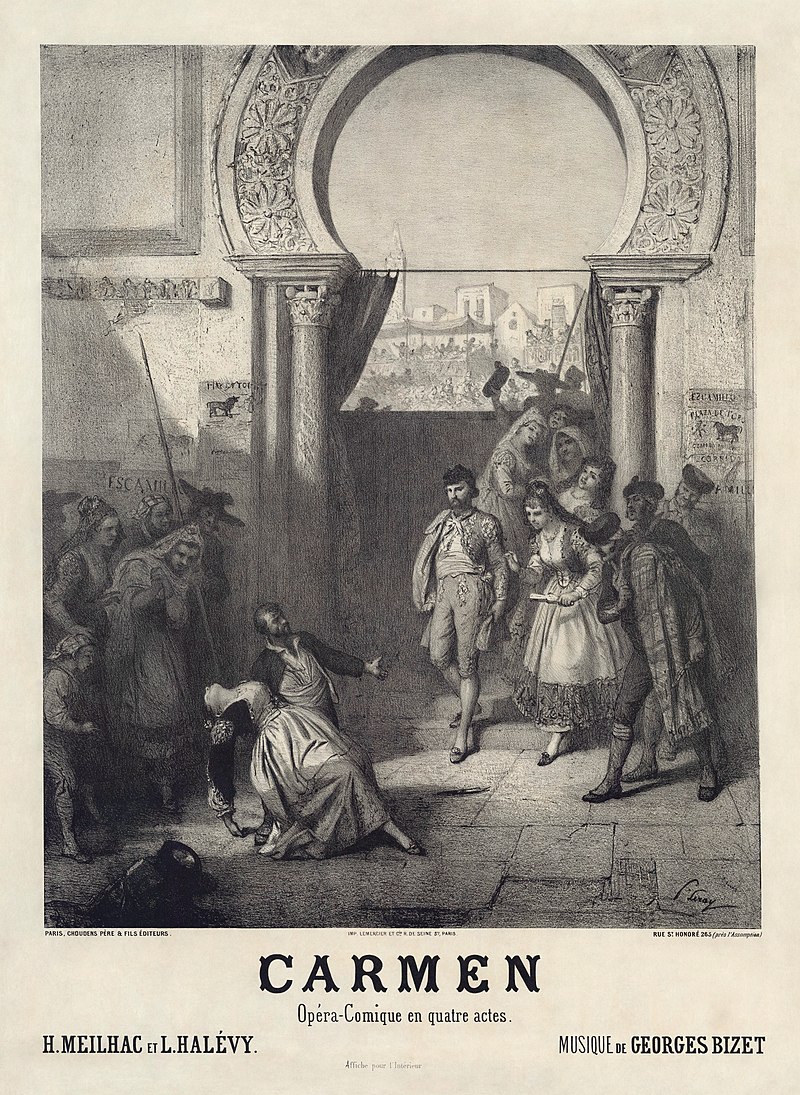
There are several examples of Carmen in the form of curled corner sign and perhaps it is a reference to this form? However, there are other designs with curled corner examples but no corresponding “medallion” entries in Sahling’s notebook.
Size & Shape and Advertising Placement
As a tray, No. 95 only comes in an oval shape, all of which have a black rim. Advertising text usually appears on the rim, always in gold; we have never seen advertising text on the face of the tray. As mentioned above, this design appears frequently as a curled corner sign and one time we’ve encountered this as a small self-framed-tin (SFT) sign without any advertising.
Hager & Price
Hager briefly mentions “Carmen” in the subsection “The Question Marks” as being “in the style of No. 86 and No. 87 (“Sierra” and “Murietta” respectively) as a way of placing her order in the catalog. Apparently he had not encountered an example with a stock number. Oddly enough, unlike almost every other design for which he did not have a stock number, he does include this design in his catalog, putting it incorrectly in the spot of No. 88 (“Colin”). Because he did not know the stock number, he does not include it in his date of introduction table.
Prices for this design (for examples in comparable condition) are better than average, although not outstanding. For such a fairly scarce design one would expect them to be a little higher.
Size & Shape and Advertising Placement
As a tray, No. 95 only comes in an oval shape, all of which have a black rim. Advertising text usually appears on the rim, always in gold; we have never seen advertising text on the face of the tray. As mentioned above, this design appears frequently as a curled corner sign and one time we’ve encountered this as a small self-framed-tin (SFT) sign without any advertising.
Hager & Price
Hager briefly mentions “Carmen” in the subsection “The Question Marks” as being “in the style of No. 86 and No. 87 (“Sierra” and “Murietta” respectively) as a way of placing her order in the catalog. Apparently he had not encountered an example with a stock number. Oddly enough, unlike almost every other design for which he did not have a stock number, he does include this design in his catalog, putting it incorrectly in the spot of No. 88 (“Colin”). Because he did not know the stock number, he does not include it in his date of introduction table.
Prices for this design (for examples in comparable condition) are better than average, although not outstanding. For such a fairly scarce design one would expect them to be a little higher.
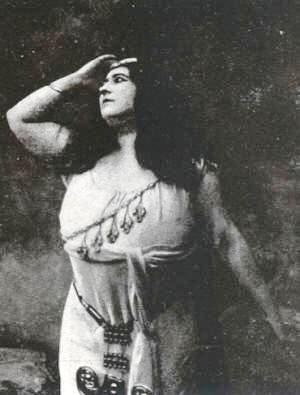
Click the Picture to Return to Meek & Beach Stock Catalog Page
